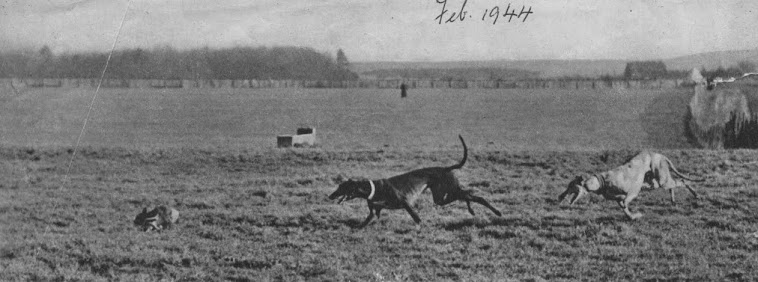A few weeks ago I posted some
photographs of coursing greyhounds depicted in Roman mosaics of the third
century AD, now in the famous Bardo Museum in Tunis
The central character in this
well-worn myth is the third Earl of Orford, the man who revolutionised
greyhound sport when he created the Swaffham Society, the first public coursing
club, in 1776. Lord Orford was a man surrounded by all sorts of wacky legends,
which are discussed at length in my recent article in Performance Sighthound
Journal, “Coursing in Eastern England”, but the most romantic one concerns the
manner of his death.
So far, so suitable for a mawkish film by
Stephen Spielberg, but Czarina occupies a central position in greyhound
breeding to this day. As the dam of the famous sire Claret, she is accepted as
the ancestress of every greyhound running. Does this mean, therefore, that
every modern greyhound has an itzy bitzy dollop of bulldog blood in it? Lord
Orford was the breeder synonymous with the bulldog cross, and so surely Czarina
has passed a share of it on down the centuries?
Everyone
should read the excellent essay, “Czarina, Bulldog Legend or Mythology?” by
James McCormick and Susan Burley. You will find it on the marvellous Greyhound
Data website.The authors argue persuasively that Czarina was
not bred by Lord Orford, but was acquired from a William Woodley Esquire of
Eccles. Mr Woodley was a member of the Swaffham Society and a considerable
person in the Norfolk of the times, serving as High Sheriff of the county. In
1792 he won the first running of the Swaffham Cup, staged to commemorate the
recently deceased Lord Orford, with his Warrant, of which a popular print was
made and which is often reproduced.
If Czarina escaped the taint of the bulldog,
there is no doubt that breeders experimented with the cross with Lord Orford in
the lead. Thomas Goodlake’s “Courser’s
Stud Book of 1828” claimed, “The late
Lord Orford, intent on obtaining as much perfection in the breed as possible,
introduced every experimental cross, from the English lurcher, to the Italian
greyhound. He it was that first thought of the cross with the English bull-dog,
in which he persevered in opposition to every opinion, until after breeding on
for seven removes, found himself in possession of the best greyhounds ever
known; and he considered this cross produced, the small ear, the rat tail, the
fine silky coat, together with that quiet innate courage which the high-bred
greyhound should possess, preferring death to relinquishing the chase.”
This would be all very well if greyhounds had
not possessed this long list of desirable characteristics for centuries before
Orford had dreamt up the bulldog cross. Thomas Thacker, who published his
“Courser’s Companion” six years after Goodlake, has no time for the cross, and
cites two famous breeders of the day, Lord Rivers and Mr Mundy, who considered
it undesirable. Interestingly, Mr Mundy blames the bulldog cross for greyhounds
of a light fawn colour rather than of brindle. Thacker, the most famous
coursing judge of his day, quotes the opinion of a friend who asked him, “Can
you improve the speed of a racehorse by a cross with a cart stallion? Is it
possible, by crossing and re-crossing, to improve the speed? Even so it must be
with the bull-dog and the greyhound bitch; the idea is the most absurd nonsense
imaginable.”
Despite Thacker’s dismissive conclusion, the
obsession with the bull-dog cross was still alive when “Stonehenge ”
published “The Greyhound” in 1853. “Stonehenge”, who was John Henry Walsh,
editor of “The Field” magazine, gave the old controversy a new polish when he
wrote, “From an examination of the facts of the case, my belief is that the
bull dog cross developes (sic) the animal courage, and that it also somewhat
increases the mental faculties, so that the dog is inclined to run cunning but
not slack. This point should therefore be considered; but as I fancy it will be
found that the increase of jealousy and courage will almost always overpower
the tendency to lurch, the advantages will more than counterbalance the
disadvantages to the public courser.
It should not be thought that “Stonehenge ”
was advising breeders to cross their own bitches with a bull-dog. He was merely
recommending contemporary stud dogs like “Vraye Foy” which were rumoured to
have a dash of the bull-dog in their pedigree. If Vraye Foy had bull-dog in his
pedigree, it was in the twelfth generation. Stonehenge
is unable to trace further back than three generations, and so the whole thing
may be a fairy tale.
Everyone should have felt thoroughly relieved
when in 1882 the National Coursing Club published its first Greyhound Stud
Book, the original breed register. From 1882 onwards the greyhound breed was closed and the
pedigrees of purebred greyhounds were established fact rather than apocryphal.
Even so I can remember a Waterloo Cup winner of
the 1970’s whose head had a distinct look of the bulldog about it. But then, I
have webbed feet and my forbears crawled out of the swamp a very long time ago,
even before Lord Orford’s greyhounds coursed the fields of Westacre and
Narborough.


.jpg)

